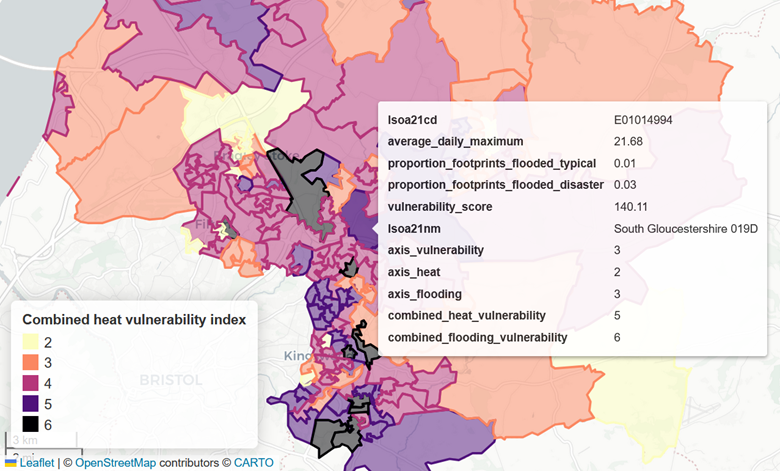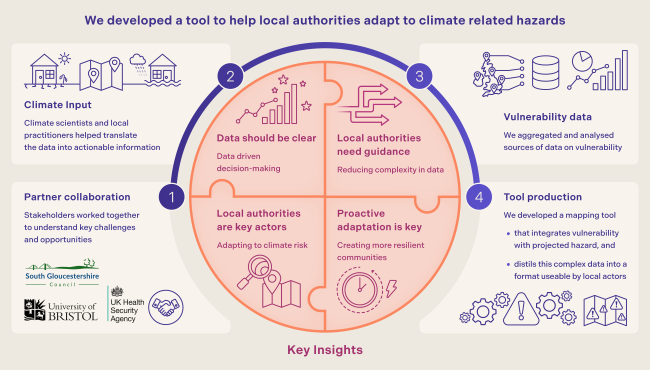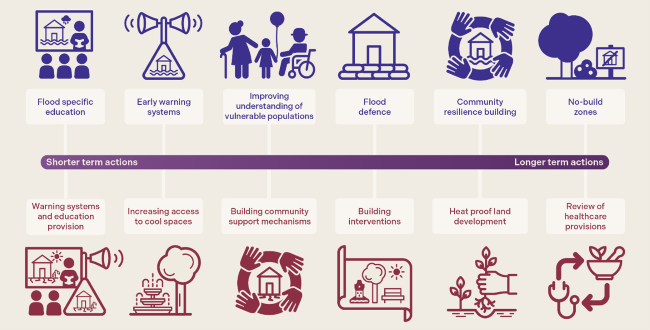Building Local Authorities’ Resilience to Climate Change: Recognising and Responding to Vulnerability
Climate change is increasingly contributing to global rises in ill health and death. Adaptation efforts are not keeping pace with the scale and speed of the challenge. Without targeted interventions, climate change will deepen existing health inequalities, as its impacts are not felt evenly.
The UK’s extreme heatwaves in 2022 were linked to thousands of excess deaths(1).
Key climate-related health risks include extreme heat, the impact of heat and drought on nutritional quality, flooding, and water scarcity.
The risks arising from climate change are shaped by a dynamic relationship between the nature of the hazard, the exposure, and vulnerability.
However, people’s vulnerability to these risks varies, shaped by existing sociodemographic and structural factors (2) such as age, ethnicity, education, household income, and disability.
These vulnerabilities are complex and interlinked, so understanding how hazard, exposure, and vulnerability intersect is crucial for identifying at-risk populations and designing effective adaptation strategies.
To assess vulnerability we used open data such as from the 2021 Census of England and Wales, and the English Indices of Deprivation 2019 (Figure 1).
Mapping and quantifying population vulnerability is a key step towards this goal of adapting well to living with the effects of climate change.
What We’re Doing Next
UKHSA’s Centre for Climate and Health Security will use the insights gained from the pilot, combined with other ongoing stakeholder engagement, to continue to enhance and refine the products and services it offers to support adaptation efforts relating to the health effects of climate change.

Pilot Engagement and Insights
Over six months, three rounds of surveys and a dedicated online workshop were conducted with officers from South Gloucestershire Council’s People and Place directorates. Key insights emerged around three themes: data, decision-making, and usability.
Data
Participants highlighted the importance of data validity, comparability, and transparency. There was a strong desire to add local datasets to enhance relevance and address perceived limitations in existing risk data. The tool and data pipeline developed supported the visualisation and understanding of this data. There remains a challenge in developing a data pipeline that can continue to work as data sources change in the future.
Decision-Making
The tool was seen as useful for informing decisions, supporting funding bids, and encouraging internal discussions. However, questions were raised about the applicability of externally developed tools and the scale of data used. As one participant noted:
“…part of the challenges with […] indexes, you’re trying to produce a summary measure […], and that’s beneficial in terms of broad prioritisation, but it loses its utility in terms of […] actionable information” (South Gloucestershire Council Participant)
Usability
Our pilot demonstrated the potential of such a tool to inform local action, but also highlighted the need for ongoing iteration and user-informed improvements. Users emphasised the need for clear navigation, transparent labelling, and the ability to integrate the tool with other local datasets and decision-support platforms. Continued development is needed to ensure the tool is intuitive and relevant for a range of users.


Key insights
• Local authorities play a vital role in building community resilience to the health effects of a changing climate but need improved tools and intelligence to support effective decision-making (Figure 2).
• Building resilience requires proactive adaptation efforts that reduce risk and enable communities to recover more quickly.
• Local authorities are essential actors in this space, translating research and national strategies into local interventions. Supporting them to do this effectively—particularly in resource-constrained contexts—is critical.
• Data to assess heat and flooding hazard are in complex formats, often unfamiliar to data analysts working for local decision makers.
• Mapping tools can improve the visibility of risks and support prioritisation. When co-developed, these tools benefit from academic rigour, public health insight, and local relevance.
• There are rich sources of data, however there were challenges in (a) selecting relevant data, (b) identifying data relating to consistent geographic areas, and (c) identifying proxy variables where data requested for the inclusion by expert panel was not available directly.
• Tools of this kind, especially when co-developed with local expertise, can guide climate adaptation action by helping to identify vulnerable populations and areas most at risk (Figure 3).
• Given the scale of the threat, the complexity of the challenge, and resource constraints, more targeted support is needed to enable local organisations to reduce risk, build capacity, and prioritise action(3).
• Stakeholders cited key barriers including limited resources, siloed working practices, and insufficient access to public health intelligence to support evidence-based decisions.
Further information
J. Howkins, Daniela N. Schmidt, James Thomas, Robert Hayward, Y.T. Eunice Lo, Jeffrey Neal, James Lewis, Elspeth Carruthers, Samuel Coleborn, Virginia Murray, Isabel Oliver, Mapping vulnerability to climate-related hazards to inform local authority action in adaptation: A feasibility study, Public Health in Practice, Volume 8, 2024, 100549, https://doi.org/10.1016/j.puhip.2024.100549
1 UKHSA. Heat mortality monitoring report: 2022. Accessed 27/05/2025. https://www.gov.uk/government/publications/heat-mortality-monitoring-reports/heat-mortality-monitoring-report-2022
2 UKHSA. Adverse weather and health plan equity review and impact assessment 2024. Accessed 27/05/2025. https://www.gov.uk/government/publications/adverse-weather-health-plan-equity-review-and-impact-assessment/adverse-weather-and-health-plan-equity-review-and-impact-assessment-2024#known-inequalities-in-relation-to-adverse-weather-health-risks
3 Vo MV, Ebi KL, Busch Isaksen TM, Hess JJ, Errett NA. Addressing Capacity Constraints of Rural Local Health Departments to Support Climate Change Adaptation: Action Is Needed Now. International Journal of Environmental Research and Public Health. 2022;19(20):13651. https://doi.org/10.3390/ijerph192013651
Authors
Dr Joshua Howkins (Centre for Climate and Health Security, UKHSA).
Prof Daniela Schmidt (University of Bristol, School of Earth Sciences).
Dr Tara Quinn (Centre for Climate and Health Security, UKHSA).
James Thomas (University of Bristol, Jean Golding Institute for data-intensive research).
